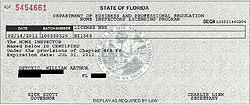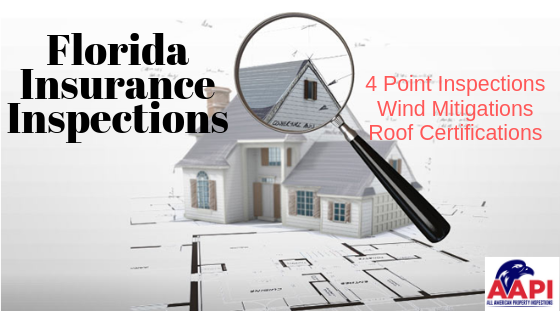
by Bill Ostoyic | Services
A Florida Insurance Inspection on your home is different than having a thorough Home Inspection performed.
 There are three Insurance Inspections that you may need or even want. Two of these are mandatory under certain circumstances before the insurance company will even write you a policy. The third one is more for you, the homeowner, to save money yearly on your insurance.
There are three Insurance Inspections that you may need or even want. Two of these are mandatory under certain circumstances before the insurance company will even write you a policy. The third one is more for you, the homeowner, to save money yearly on your insurance.
A Home inspection, on the other hand, is for you the buyer or even the seller. This is a complete overview of the home, appliances, electric and so forth. Curious about what we inspect and is included in our home inspections read all about it here…
>>> What is Included in a Home Inspection <<<
Required Insurance Inspections
4 Point Inspection – This inspection is required on homes that are 30+ years or older. It checks the 4 biggest components of a home that if something was to go wrong would cost the most to fix. These components are the Electric, Plumbing, Roof, and HVAC (Heating and Air Conditioning)
To find out more and schedule your 4 Point Inspection, read our post all about 4 Point Inspections and what to expect from them.
Roof Certification – One of the major concerns here in Florida for insurance companies is the life expectancy of your roof. It’s safe to say that replacing a roof can cost thousands of dollars and dependent on the shape of your roof, there may be damage that will need to be fixed.
For that reason, an insurance company may request that your home get a roof certification stating the condition of your roof. If this is the case check out our page Florida Roof Certifications and let’s get you scheduled so we can get you taken care of.
The Florida Insurance Inspection You’ll Want to Get ASAP
The one inspection that you probably don’t know about, is not available in all states and that will save you money, yearly, on your home owner’s insurance is…
Wind Mitigation Inspection (also known as Windstorm Inspection) – This is one of the simplest inspections you’ll ever have done on your home. It takes about 15 minutes is an easy report and can save you lots of money over the years on your insurance.
This inspection will look at different items in your home that each carries a certain percentage of a discount. So the more items you have in your home that are what the insurance companies are looking for the bigger your yearly discount will be.
Find out in our article on Florida Wind Mitigation Inspections the items we inspect and be sure to schedule your windstorm inspection today.
FYI – A Wind Mitigation is a Florida statute (law) so the insurance companies have to give you the discounts.
by Bill Ostoyic | Services
Let’s ease your mind right away…A home inspector does not pass or fail a home.
The home passing or failing depends on the buyer either buying the home or walking away.
One hitch that sellers often run into when preparing their home for entering the market is failing to have a home inspection before listing the home to sell. When a deal does not go through it may seem like your home did not pass inspection but it really depends on the person buying the house and what their willing to negotiate.
There are many things that are quick and easy to repair but to a home buyer, they may seem like major issues or there may be a lot of little things that appear like there is a lot wrong with the home.
Some potential areas of trouble may include the presence of water staining and mold, wood decay, or other safety issues like old electrical services, faulty wiring, severe dry rot or structurally unsound stairs or decks. If your home is an older one, it may need more maintenance and repairs that you wouldn’t know about unless you hired an inspector.
Typically, just about any problem can be fixed on a home, which is why it’s so important for you as the seller to get a home inspection performed on your home before you put it on the market.
It is in the best interest of home buyers to always have a home inspection even if the seller says they’ve already had one done because the seller may have had hired a home inspector to tell the seller exactly what they want to hear. This is why sellers should also have a second opinion in mind. If the buyer has a home inspection and determines that the first inspection was not up to par, they can always renegotiate. This is why a second opinion is typically always best for both parties.
The first step after receiving the home-inspection report is to fix the problems that were present in the report. After you make the appropriate updates, it will be unlikely that any potential buyers will find something that will cause them to walk away from purchasing your home. Having the repairs done before a potential buyer has a home inspection done may also save you a lot of money by buyers wanting to negotiate a lower price because of repairs or potential repairs.
Sellers typically can avoid failing a home inspection by having the home inspected several months prior to putting it on the market. This gives you more opportunities to learn about the potential projects that the home needs in order to have it pass inspection.
All American Property Inspections is proud to offer home inspections in Windermere, Orlando, Lake Mary, Longwood, Apopka and all the surrounding cities in the central Florida area. Hiring a home inspector is a protection for your huge investment that you have in your home and a major benefit in the process of selling your home. With extensive construction experience as well as thousands of inspections performed, AAPI is a company you can trust for your home inspection needs.

by Bill Ostoyic | Services
Electrical systems can be complex and confusing. As a result, many homeowners don’t see the signs of potential damage before problems occur. Having your house inspected by a professional is the only way to be sure that your house is wired properly and safely.
It may not be easy to find the best electrical inspector if you don’t know a lot about wiring, but with a little bit of know-how, you can know what to look for. Finding these tell-tale signs of faulty or worn out wiring is critical in preventing possible electrical fires in your home.
If you are unsure of which electrical inspection company to hire, consider the inspectors reviews and asking the inspector about their electrical knowlege before hiring them. 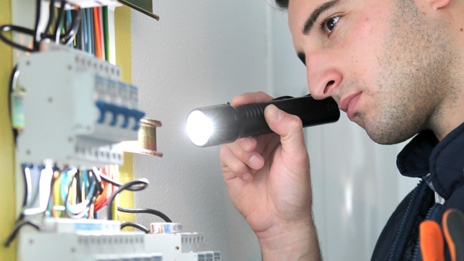 This will help you to get an idea of how extensive a particular company will go when inspecting your home and how much they may charge for their services. Be sure to compare each company in terms of how complete their services are and not just by how much they charge. This increases your chances of getting the most qualified company providing the most professional inspection services.
This will help you to get an idea of how extensive a particular company will go when inspecting your home and how much they may charge for their services. Be sure to compare each company in terms of how complete their services are and not just by how much they charge. This increases your chances of getting the most qualified company providing the most professional inspection services.
Electrical inspectors have a solid understanding of the electrical requirements for the area that they work in. By utilizing a company that is licensed and fully trained, you can be confident that you are receiving a high-quality inspection that will provide detailed information about the status of the electrical systems in your home.
Every home, no matter what the age or condition, can benefit from an electrical inspection. Whether you are looking for a full home inspection, or simply want to evaluate your wiring and lighting systems, having a knowledgeable electrical inspector on your side can make the difference between having a home that functions safely and effectively, and one that is not safe due to a potential for fire or electrical damage.
Call AAPI today for a Home inspection!

by Bill Ostoyic | Services
All homes have Mold!
I know, pretty bold statement and could be alarming…until you know the facts!
As a certified mold inspector, I look for signs of mold as I am looking for issues with water or moisture and no, I do not charge extra since I am already looking for water issues.
Having a mold inspection performed is completely different than inspecting for mold. Mold Inspections requires taking samples of air in areas of the home and comparing it to samples of air taken on the exterior of the home. The air samples are compared to see if there are different molds in the home, the kind of mold, and the levels of mold. In order for the mold inspection to be done properly, the home should be shut and not entered for 48 hours in order to get proper readings. What I do is I pay close attention to places in the home where there is water.
Most Common Places You Find Mold
Places like the bathrooms, looking on the baseboards and looking in the cabinets underneath the areas of the pipes looking for any signs of leaking, water staining, or water damage, as well as looking for signs of mold growth.
Any place where there is a sink or a toilet are areas of concern but many people do not realize one of the most prominent places of mold growth is the air-conditioning system.
How the air handler of the air conditioning system works is that it removes the humidity from the air. When the hot air comes across the cold coils it creates condensation. The condensation travels down the coils into the drip pan and exits the home through the drain pipe. If there is a build up of dirt, hair, dust or other things on the coils of the air handler, mold will have the ability to grow on these things when the air conditioner is off and the temperature and humidity levels rise to a level that is conducive to mold growth.
This is why it is very important to make sure that you change your filters regularly and maintain your air conditioning systems in a clean, functional, manner.
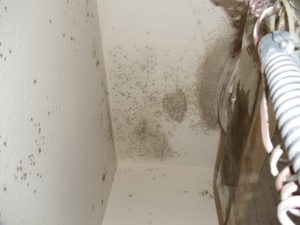
Mold found in AC Closet
It is very common to find surface mold on the air-conditioning duct above the air handler especially if the air handler is in the garage or the attic. The garage and attic are typically very warm and humid which is perfect for mold growth. Any area where the duct leaks is an area susceptible to mold growth.
What I tell my clients to do, is to move the air filter to a hinged grate on the inside of the home where the air filter can be replaced and to remove the air filter from the return side of the air handler so that you can completely seal the air handler unit so that there is no air transfer from the cold interior of the unit and the hot humid air on the exterior of the unit which will greatly hinder and decrease the ability of having mold issues.
If I find any evidence that I believe warrants a mold inspection I inform my clients so that they may have a mold inspection done. If the clients just want peace of mind then they can do a mold test that you can get from any Home Depot or Lowe’s and perform them themselves instead of me charging them to do it for them which will save them a lot of money.
Finding evidence that warrants a Mold Inspection
If I find any evidence that I believe warrants a mold inspection I inform my clients so that they may have a mold inspection done. If the clients just want a peace of mind then they can do a mold test that you can get from any Home Depot or Lowe’s and perform them themselves instead of me charging them to do it for them which will save them a lot of money.
Another area of concern is around the windows. Caulking around the windows separates after a few years and allows moisture to seep into the walls causing water staining, damage and sometimes mold. I pay close attention to these areas as well as any areas on the exterior of the home that may have the ability to allow water to access the home. I tell my clients that a house is like a boat. You want to keep all the water on the outside.
Save
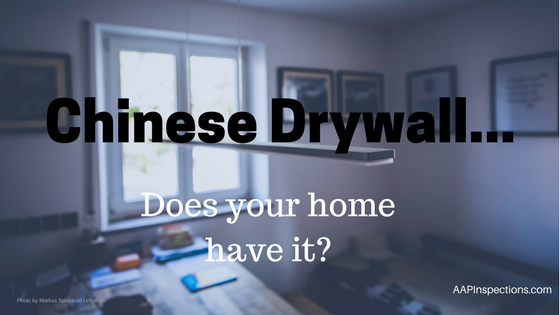
by Bill Ostoyic | Services
Chinese drywall is said to have some health effects such as respiratory issues and headaches. The vast majority of the Chinese drywall that was brought to America was in the early to mid 2000’s which the dates vary depending on which website you go to but the consensus seems to be from 2001 to 2009.
There is some concerns of homes having Chinese drywall in the Central Florida area.
According to some websites, the majority of the Chinese drywall came into South Florida and went up the West Coast of Florida all the way to Louisiana and Texas. It does not appear that much of the Chinese drywall made it to Central Florida but it has been found in the Central Florida area.
The problem with the Chinese drywall is that the chemical makeup that is in the drywall has a bad reaction to metals, primarily copper. The sulfur and acidic compounds of the Chinese drywall caused copper to corrode and cause electrical components within the home to not function properly and need replacement.
Items in the home that are susceptible are electronic devices such as televisions, microwaves, and computers, but one of the big issues is with air conditioning systems. It is been reported that the average life expectancy of an air-conditioning system in a home with Chinese drywall is six months before it fails. The corrosiveness of the Chinese drywall reacts with the copper coils of the air conditioning corroding them and making the Freon leak from the unit making the system no longer able to cool.
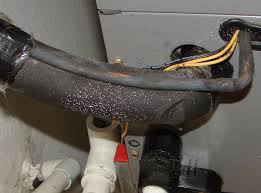
Signs of Chinese Drywall – Air Conditioning unit
Signs your home may have Chinese Drywall
There are many different signs associated with Chinese drywall but the signs can be mimicked by other items.
Blackness on copper from the corrosiveness of Chinese drywall can also happen due to corrosive cleansers that are kept near copper pipes. When inspecting a home, I look for signs of corrosiveness in different areas of the home. I look for signs of corrosion on the copper tubing of the air handler of the air-conditioning system. When the copper tubing is welded, it is cleansed by a product called flux which turns black from being welded so that cannot be taken as a telltale sign of Chinese drywall as every air conditioner will have black on the tubing.

Sulfide Corrosion on coils
When I take the cover off of the electric panel I also look at the copper wiring for signs of corrosion. When I am looking in the cabinets for plumbing leaks I look for corrosion on pipes that are visible but as stated earlier, corrosion may be caused by other items that have corrosive chemicals such as ajax, comet, or other cleansers or chemicals stored around pipes.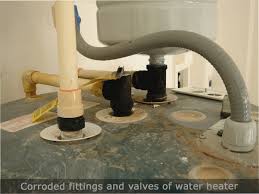
The other place that I am looking for evidence of Chinese drywall is in the attic above the garage where there is no insulation. Drywall is stamped with the manufacturer label of where it was produced. I have found Chinese drywall that is stamped from coming from Beijing China. I have also found drywall that was stamped as being made in America where the drywall was repapered and stamped as American. Whether the drywall came from China or America did not matter to me as it was having an adverse affect upon the copper within the home and I reported it as such.
It is also noted that Chinese drywall will put off a sulfurous rotten egg smell. The problem arises by trying to use this as a method of determining Chinese drywall because when water sits in pipes and in the hot water heater, it releases the same kind of smell when the water is turned on at the faucets. Every sign of Chinese drywall can be caused by a multitude of different sources that have nothing to do with drywall. This is why the state of Florida declares that Chinese drywall can only be detected by having the drywall chemically analyzed which means parts of the drywall will have to be cut and removed from the home and sent to a lab.
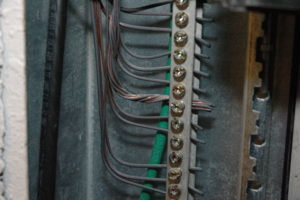
This goes beyond the scope of a home inspection as a home inspector is not allowed to cause damage to a home.
If you suspect that a home may have Chinese drywall then it will have to be worked out to have the drywall chemically analyzed in order to prove that Chinese drywall exists within the home.
Save

by Bill Ostoyic | Services
As you can imagine, there are many different components that make up a house. From the foundation that was laid to the walls that were erected to the roof that covers everything in between like the electricity, doors, windows, and plumbing.
Below you will find a list of everything that, by law, a Home Inspector is legally obligated to check and report on.
Besides some of these components, I explain what exactly I’m looking for and why.
- Structural components including foundation and framing of the home – The first thing I check upon arrival of the home is the exterior features and structural components. As I go around the house I am looking for everything from possible drainage issues where water can flow back toward the house or areas of bad drainage, or water issues that may arise from rain coming off the roof. I am also looking for signs of wood-destroying organisms; termites, mold, and wood decay.
- Exterior features including siding, soffit, porches, balconies, walkways, railings and driveways – If the exterior of the home is brick or stucco I am looking for any evidence of damage, cracking or settling. If the exterior is wood or siding of another kind, I am looking to make sure that it is not damaged, or decayed, and that the exterior of the home is properly caulked and sealed. I also inspect every outlet and plumbing fixture as well as the air conditioning and parts of systems that are located on the building exterior.
- Roof system including shingles, flashing and skylights -The roof is inspected in different ways depending on the age and type of roofing. Shingle roofs are the only kind that the home inspection certification will allow us to walk on. Tile and metal roofs can be damaged from being walked on so if you have a roof that is not shingle, make sure only a roofer walks on it to keep it from being damaged. On roofs that I am not allowed to walk on, I inspect with high powered binoculars or by putting my ladder on the roof edge and inspect the roof from the top of the ladder. Shingles on lower roofs should not have a ladder put on them to get to the upper roof due to the damage the ladder causes on the shingles of the lower roof. The roof is inspected from the top side and also from the attic.
- Electrical system including service panels, breakers, and fuses
- Plumbing systems including pipes, drains, water heating equipment, and sump pumps
- The heating system including equipment and venting
- Cooling system including energy sources and distribution equipment
- Interior features including walls, ceilings, floors, windows, doors, stairs, and railings – The interior of the home has an extensive amount of things and areas inspected. Every outlet and light switch is inspected, every plumbing fixture, every appliance, every door, window, and the built-in drawer is opened and closed. Close attention is paid on the baseboards and around windows for signs of water intrusion and termite activity. My flashlight uses a white light the makes any water staining very visible. When I am inspecting the interior, I am also looking for any signs of previous repairs that may be hiding an issue. While on the interior, I take off the electrical panel to make sure the wiring is right and that there is copper or aluminum wiring. I also take the cover off of the air handler or furnace to look at the inside of the unit and make sure that the cooling coils are clean and free of mold and blockage.
- Insulation and ventilation including those in the attic and other unfinished spaces – While in the attic, I am looking for any signs of roof damage or water staining on the roof decking but while I am in the attic I am also looking at the insulation, plumbing, electrical and air conditioning components as well. If there are openings in the exterior of the home to the attic, it is not uncommon to find field mice or other rodents have found their way into the attic.
- Fireplaces including chimneys and vents
Components NOT included in a Home Inspection
- Termite and Pest Control Report
- Well Systems
- Mold Inspection – Even though a specific Mold Inspection is not included you can find out what I look for as far as mold goes in this article, “Looking for Mold during the Home Inspection”
- Sprinkler systems – These systems continually require repairs and adjustments. I used to inspect sprinkler systems but the lawn maintenance people would run the sprinkler over after I inspected them and I would get a call asking me why I said that the sprinkler system was fine when sprinkler heads were damaged. I will turn a system on to make sure it comes on but while I am inspecting the exterior of the home, I am looking for areas and signs that the sprinkler system needs repairs or adjustments.
- Fire and smoke detection and suppression systems – If I check the smoke detectors and they all work fine, it might be a month or two before the client takes possession of the home and the batteries may have died since they were inspected. I put in every one of my reports that the smoke alarms should be tested when the property is taken possession of and then put on a maintenance schedule.
- Alarm systems are also not inspected because when you put the system on in your name, the company will come out and service the system and if you go with a different company, then there was no sense in inspecting the system that is getting replaced.

 There are three Insurance Inspections that you may need or even want. Two of these are mandatory under certain circumstances before the insurance company will even write you a policy. The third one is more for you, the homeowner, to save money yearly on your insurance.
There are three Insurance Inspections that you may need or even want. Two of these are mandatory under certain circumstances before the insurance company will even write you a policy. The third one is more for you, the homeowner, to save money yearly on your insurance.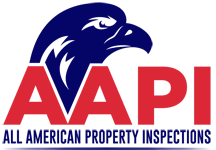

 This will help you to get an idea of how extensive a particular company will go when inspecting your home and how much they may charge for their services. Be sure to compare each company in terms of how complete their services are and not just by how much they charge. This increases your chances of getting the most qualified company providing the most professional inspection services.
This will help you to get an idea of how extensive a particular company will go when inspecting your home and how much they may charge for their services. Be sure to compare each company in terms of how complete their services are and not just by how much they charge. This increases your chances of getting the most qualified company providing the most professional inspection services.










